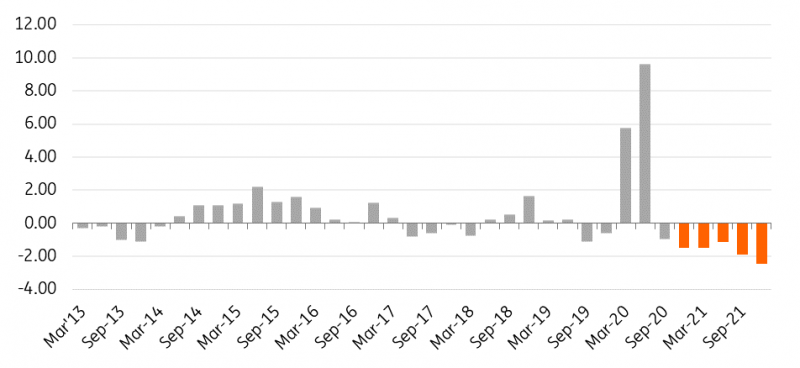Tighter Times Ahead For The Oil Market

Saudi Energy Ministry, Prince Abdulaziz bin Salman Al-Saud, Minister of Energy of Saudi Arabia, chairs a virtual summit of the Group of 20 energy ministers to coordinate a response to plummeting oil prices
OPEC+ to continue with cuts
This year has seen OPEC+ taking extraordinary action to try and stabilize the oil market.
The unprecedented fall in oil demand this year, and in particular over 2Q20, left the market drowning in supply. In April, we saw OPEC+ members putting aside differences and agreeing on historic record production cuts as a result of COVID-19. The group agreed to cut output by 9.7MMbbls/d over May and June, though this has been eased throughout the year, with the group currently cutting by 7.7MMbbls/d.
Under the original deal, the group was set to ease further starting in January 2021, reducing the level of cuts to 5.8MMbbls/d, which would then be in place until April 2022. However, with the demand recovery this year taking longer than initially expected, coupled with a surge in Libyan supply, the group has been forced to revisit this plan, given the risk that easing too much at the beginning of 2021 could push the market back into surplus.
After a tough week of meetings in early December, OPEC+ finally agreed to ease output less than originally planned. Therefore, from January 2021, the group will ease cuts by 500Mbbls/d, leaving the level of cuts at 7.2MMbbls/d. From there, OPEC+ will assess the market on a monthly basis and decide whether to ease further. Under the revised deal, the group will ease by a maximum of 500Mbbls/d per month.
While taking this approach may be more appropriate than the expected three-month rollover of current cuts given the uncertainties around the demand outlook, it does create more uncertainty around what OPEC+ may decide each month, and so the potential for increased volatility in the first few months of 2021.
We believe that the changes the group made to the deal will be enough to ensure that the market does not return to surplus in 1Q21. While for the remainder of the year, we would expect the market to continue drawing down stocks.
Limited non-OPEC supply growth
OPEC+ was not the only one to respond to the weaker price environment that we saw this year. Non-OPEC+ producers were also quick to shut-in production in 1H20 due to the build-up in stock, and the weak price environment. At its peak over May, we saw somewhere in the region of 2.7MMbbls/d of non-OPEC+ production shut in, with the US standing out, having shut in a little over 1MMbbls/d of production in May.
However, what has been even more surprising, is that with the fairly quick recovery in oil prices from the April lows, producers have been quick to bring back this shut-in production. The US has basically brought back all shut-in production, while Norway seems to be the only meaningful producer to still have shut-in production, although that is due to mandated production cuts put in place earlier in the year.
Non-OPEC supply has fallen significantly this year, too, and we are set to only see limited growth in this supply next year, with less than an 500Mbbls/d increase YoY, which still leaves non-OPEC supply in 2021 well below 2019 levels.
In the US, while we have seen a more recent pick up in rig activity, it is still well below pre-COVID-19 levels, with the number of active rigs in the US standing at 241, down around 65% since mid-March. Therefore, it is difficult to see the US returning to growth anytime soon. We would need to see a further pick up in prices before producers are willing to increase spending, and as a result a significant pick up in drilling activity. Producers will likely rely on drilled but uncompleted wells (DUCs) in order to try to sustain production levels, although these DUCs have only been declining at a fairly modest pace in recent months. For 2021, US production is expected to fall by a further 300Mbbls/d YoY to leave output averaging 11.1MMbbls/d. This compares to an estimated 850Mbbls/d YoY decline in 2020.
Demand uncertainty
The biggest uncertainty and risk for the market remains the demand outlook.
While recent vaccine developments are positive for the demand outlook in the medium term, there is still plenty of uncertainty over demand in the short term, and this is likely to be the case until a vaccine becomes widely available, allowing us all to return to a more normal life. Before that comes, there are risks of further COVID-19 waves and lockdowns, and international air travel is likely to remain very limited until governments feel comfortable easing border restrictions and quarantine requirements. Assuming that we see a vaccine becoming widely available from spring into summer, we believe that we will see a robust demand recovery over the second part of 2021.
However, we are still unlikely to return to pre-COVID-19 levels in 2021, we are currently assuming that demand will grow by around 6.7MMbbls/d next year, after having fallen by around 10MMbbls/d this year. It appears we will have to wait until at least 2022 to reach pre-COVID-19 demand levels once again.
Iranian supply risk
While demand is a big uncertainty for the market, another key downside risk for the market is Iran. Following the outcome of the US election, it is looking more likely that the US will return to the Iranian nuclear deal, and with that the potential for the removal of sanctions. Such action could bring anywhere between 1.5-2MMbbls/d of supply back onto the market.
However, the big unknown is timing, as it is not known how high Iran is on President-elect Joe Biden’s priority list. If we were to see a fairly quick return of Iranian supply over 1H21, this could put some pressure on the market, with the market likely finding it difficult to absorb additional barrels. However, if we only see Iranian supply starting to come back in the latter part of next year, the market should be able to digest this oil more easily, given expectations of demand continuing to recover as we move through the year.
Stronger prices through 2021
We expect that the oil market will draw down inventories throughout 2021, as demand continues to recover. The key risk was around 1Q21, but OPEC+ has addressed this with its recently revised deal.
We forecast that ICE Brent will average US$55/bbl over 2021 and likely end 2021 in the region of US$60/bbl. This view is dependent on a vaccine allowing demand to continue recovering, along with the OPEC+ deal holding through the whole of 2021 (BNO, OIL).
Quarterly oil balance (MMbbls/d)

Source: IEA, EIA, Rystad Energy, ING Research
ING forecasts
Source: ING Research
Disclaimer: This publication has been prepared by ING solely for information purposes irrespective of a particular user's means, financial situation or investment objectives. The information ...
more


